#Holloway Sanatorium
Explore tagged Tumblr posts
Text
♫ Total Eclipse Of The Heart ♫
I haven’t played this one since March 2019, so when Clive mentioned last night that it is his favourite by Bonnie Tyler and said it was “OTT” (I had to think on that one for a minute to come up with ‘over the top’) I figured that gave me a good excuse to redux it this morning! This song from 1983, recorded by Welsh singer Bonnie Tyler, became Tyler’s biggest career hit. The song peaked at #1 in…
youtube
View On WordPress
#Bonnie Tyler#Holloway Sanatorium#Jim Steinman#Meat Loaf#music charts#music trivia#Russel Mulcahy#vampires#Youtube
1 note
·
View note
Text
Analysis of Galatea Claude (+ Holloway Sanatorium Theory)

Holloway could be where Simon was sent following his accident. His trailer did mention “sanatorium”, which is the term used in the CN and JP versions of Annie’s letter, while the English version of Annie’s letter calls it a “nursing home”, which matches with the term used regarding where Simon was sent in Lily’s deductions and backstory.
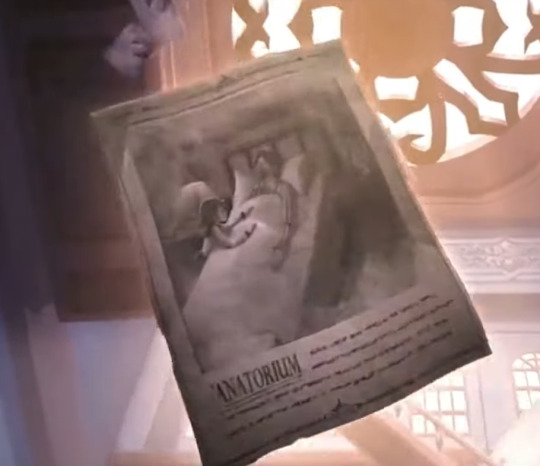

Simon and Lily, as part of the Barriere family, would be part of the middle/upper class and thus would qualify for the Holloway Sanatorium.
Also, as Simon was said to have suffered “severe brain and body trauma, becoming paraplegic, mentally regressed to a toddler, demented, and unable to speak”, this could match with how Holloway Sanatorium was said to care for those with mental health problems and learning disabilities. With this facility being for the upper class, that could also explain why Lily needs a lot of money for Simon’s medical bills, especially as, unlike Annie, Simon wouldn’t be in the “temporary ward”. He’d be long-term.

I know some have said Simon could’ve actually been sent to White Sand Street Asylum, in part due to Galatea appearing during Lily’s trailer while Lily was visiting her brother.
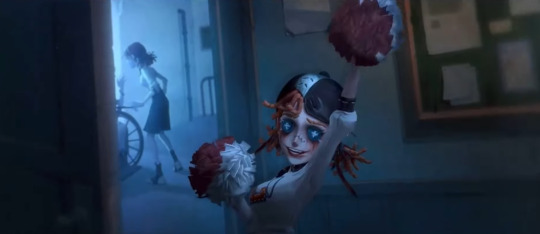
Holloway Sanatorium was built by Thomas Holloway as an asylum for the mentally ill in Surrey. They used the name “sanatorium” instead of asylum due to the “stigma attached to being admitted to an asylum”.
So it technically is an asylum, just with emphasis on those who were better-off.
It was said “it was for a superior kind of inmate, somewhere between those who had only small means, and those who were more comfortably off but who could not have afforded the luxury of individual private care (although private rooms were also provided here). The original purpose was to cater for ‘200 patients, divided into four classes, 1st, 2nd, sick and feeble, and excited. All day-rooms, dormitories and single rooms had a south and south-western aspect. Attendants’ rooms were placed between day-rooms and dormitories with a glass window or doors of communication that allowed them to keep the patients under observation’”.
In its first year, 73 patients were admitted, whose primary diagnoses included anxiety, melancholia, mania and dementia. Some patients worked in the gardens or farm, or in indoor domestic work, while during leisure they could stroll through the grounds, or play tennis, croquet, or cricket.
In 1888, “gentlewomen” were the largest number admitted “a category made up of unmarried women of a good class, but perhaps without much in the way of financial resources”. In 1892, it had 615 patients being treated for insanity caused by “domestic and business troubles, worry and overwork”. Other reasons given were “influenza, drink, nervous shock and sunstroke”.

This would at least connect to and explain Annie being there (the large number of females, the mention of causes being worry, and for women of good class but without much in the way of financial resources). Simon could also fit based on his own mental and bodily issues.
But I wanted to also bring up the idea its possible Galatea could’ve been sent here for a time too.
Galatea was born to the Claudes, who are described as a “family of artists”, and we see in Galatea’s 1st deduction that she got started as a sculptor and displaying her skill from an early age.

We see she progresses quite quickly according to her 2nd deduction, which mentions her surpassing (likely her teacher’s) expectations and who wants to bring Galatea to Paris or Florence for the better “artistic atmosphere” and “expand her vision and benefit her artistic cultivation”.
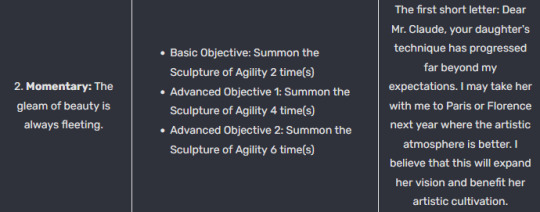
Unfortunately, when Galatea was 18, she was diagnosed with dwarfism.
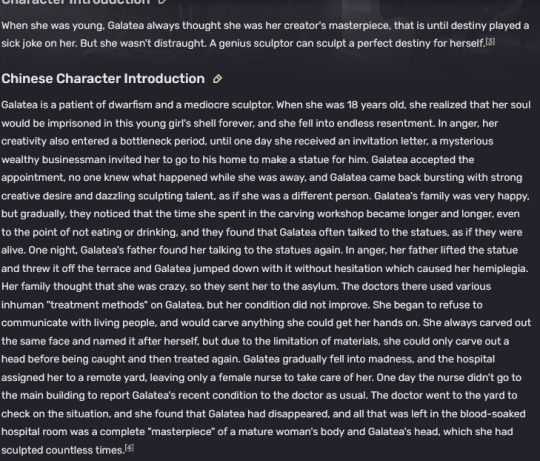
We know the Sanatorium was primarily for those with mental issues. Galatea’s 3rd deduction does have a doctor mentioning her having a “rare illness” that will cause her “serious challenges to her physically and mentally” in the long term. So maybe she could’ve been sent there right before and for a time after her diagnosis.
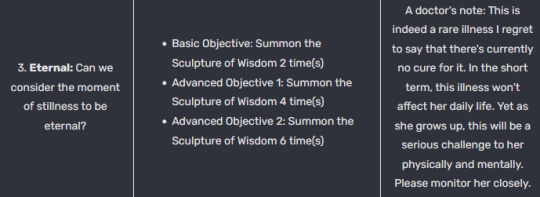
Dwarfism doesn’t typically affect a person’s intellectual ability. Those with dwarfism mostly all have normal intellectual capacities, but this is during the Victorian era, when these sorts of issues weren’t as well understood. In the Victorian era, they commonly associated physical differences or disabilities with intellectual or mental impairment and could be subjected to prejudices or discriminatory treatment. People with these sort of disabilities were seen as defective back then, with their issues believed to affect their ability to work and even their morals (due to the belief physical appearance was believed to reveal a person’s moral compass and chances at success).
This would actually connect to Galatea’s deduction 4, where we see someone saying about Galatea that “tangible beauty is out of her reach. She’s just a ‘child’ after all”. This shows that people thought Galatea as someone stuck, physically and mentally, as a “child”, which connects to how this deduction also talks about the “price of being ‘naïve’”.

Along this same line, Galatea’s 5th deduction, likely by her teacher again, says that Galatea was unable to “adapt to her new life in Florence”. Her teacher believes the reason for this is because Galatea is “still too immature, both physically and mentally”, before saying she may need a “change of environment to stimulate her talent once more”.
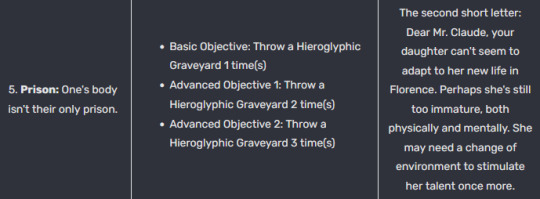
This again proves people saw Galatea’s dwarfism as affecting/stunting her mentally, not just physically.
Besides this, regarding Galatea’s inability to “adapt” should refer to how her backstory says “she realized that her soul would be imprisoned in this young girl's shell forever, and she fell into endless resentment. In anger, her creativity also entered a bottleneck period”. This creative “bottleneck” is why Galatea’s teacher suggests she change environment to “stimulate her talent once more”.
Dwarfism shouldn’t actually have any affect on Galatea’s ability to sculpt, so as we see this bottleneck was created by Galatea’s own feelings rather than any inability. Galatea was frustrated at the fact she’d forever remain looking like a child. Despite how mature she actually was, she would only ever been seen as a child, when she wanted to be viewed as equals and an adult. This belief that Galatea was only a child would also mean Galatea wouldn’t be taken as seriously. They would only ever focus on the fact that she was “defective”. Despite how vast her creativity or imagination was, or how great her mind was, Galatea was stuck on the fact she would forever be “imprisoned in this young girl’s shell”.
This connects to how Galatea is stated to like “beautiful, mature women”, something she wants to be and dreams about, but is unfortunately hampered by her being “imprisoned” in her current body due to her condition.
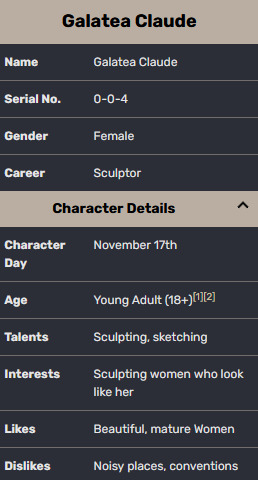
This was before Galatea gained her self-confidence. After her diagnosis, she possibly had a fair amount of self-doubt, as well as may have lacked proper support, not to mention felt the weight of how everyone around her saw her as basically less than she was due to her issue.
These were the things hampering Galatea’s ability to create. She was likely unable to focus on anything besides her issue and how people treated her as a result (which could also imply she did lack support and/or didn’t even have a sympathetic ear to listen to her feelings).
It was around this time that Galatea was said to have received an invitation from a “mysterious wealthy businessman” who “invited her to go to his home to make a statue for him”. This relates to Galatea’s deduction 6, which lists one of the envelopes as being a “check signed by Baron DeRoss”.

When she returned from this appointment, she came back “bursting with strong creative desire and dazzling sculpting talent, as if she was a different person”.
Galatea’s 3rd letter is likely a description of what she did for Baron DeRoss during this time.

The task he assigned her was to restore a “collection of sculptures dedicated to the Muses”. They were made using a technique that Galatea had imitated during her studies in Florence to “produce a number of animal sculptures”. 1 of these animal sculptures she made was mentioned in her 1st letter to be a “bird” she describes as “imprisoned in stone”.

The reason she describes it that way is to parallel herself. She is also someone “imprisoned” in a body that won’t change, just like stone. It is possible these animal sculptures were the ones she created during her “bottleneck” while she was still consumed by her “resentment” and frustration over her condition.
Her deduction 6 says there are several envelopes that had an “incomplete wax seal that seems to be part of a fern pattern”, which means they came from Oletus Manor and thus that Galatea and Baron DeRoss had more correspondence between each other before Galatea got the invitation and went to the manor. It is possible it was during this correspondence, before she got an invitation, that she sent him the bird sculpture. It’d fit with how Galatea was at that time before the trip to Baron DeRoss’ manor, as she describes the bird as “A meaningless, disorderly, insignificant work of which the spirit gradually died”, which relates to Galatea’s creative bottleneck while she was still consumed by resentment and frustration. This would explain how Baron DeRoss could’ve noticed how Galatea used the same technique as creator of the muse statues, and that would be why he invited her. This would also explain why Galatea says in her 1st letter that “when I see it again” (referring to the bird) she “destroyed it”. She made the bird, then sent it to Baron DeRoss, then when she was invited and went to his manor, she saw it again, and after seeing and studying the Muse statues, she decided to destroy the bird she made.
Unfortunately, we don’t know for sure yet who the creator of the muse statues was, the one who is described as “not a world-renowned sculptor” but was “a genius favored by art yet scorned by fate, has long since returned to ash, the tragic victim of a vicious fire”.
Although, Alice during Ashes of Memory 1 does say “These sculptures are mechanisms designed by Mr. Lapadura, and all the doors in this manor can be opened with the nightingale’s song”, though we know he has not died in a fire yet, as Burke is at least around through game 10 (with Tracy, Luca, Charles, and Bonbon). That could mean Burke may have modified the sculptures to have the mechanisms used to open the secret doors in the manor, but may not have been the one to actually sculpt them. He just designed the “mechanisms” in them.

While at the manor, Galatea studies the Muse statues and spends “an inordinate amount of time on my task, far more than necessary” due to making “a number of discoveries, ones that were not mentioned to me before”. As for the discoveries Galatea refers to, one of them is how there are “two genuine sculptures of the Muse Terpsichore in different poses”, while the 2nd discovery was “a near-perfect counterfeit of Calliope”.
Regarding Terpsichore, Galatea says it is rare to see 2 of the same figure in 1 set, and generally only happens when “a piece is lost during the sculpting process, forcing the artist to complete the original set with a new replacement”.
As for Calliope, Galatea initially says she has an “imperfection… left by her creator” before then commenting “Perhaps it isn't an imperfection at all, but an incomplete section of the sculpture? Much like the words written on the counterfeit's back (which have been rubbed away), perhaps it's simply waiting for the artist to return and finish what was started”. Galatea states Baron DeRoss needs to make a decision regarding it, likely regarding what to do or whether to complete the “incomplete section of the sculpture”. It is when he makes this decision Galatea feels she’ll return to the manor to “ensure that she is made whole”.
Besides that 1 incomplete section, Galatea finishes “restoring” what she can of the other statues. This is likely happening around the time Baron DeRoss (Orpheus) is restoring the rest of the manor and its grounds after he took over (after the manor had been ruined following the DeRoss tragedy when Alice’s parents were killed). Galatea obviously becomes obsessed over those statues and completing the one imperfection of the near-perfect counterfeit of Calliope. This could tie to how Galatea in her 1st letter says she “used to pursue the praise of fools. But now I don't have time to care for such trivial matters”, which fits with how we know Galatea is an “obsessed and crazy perfectionist” based on her design notes.
It is because of this trip that Galatea in her 1st letter talks about learning of the “fragile existence of the body itself” as well as “heard the divine birth of a sculpture” and the “truth of art breaking out of its shell”. This connects to the bird, which she described as “imprisoned in stone”, and to Galatea herself, and could relate to her now thinking about how to essentially break it and herself out of their “imprisonment”. This could tie to how the design notes say her goal is to “create a most perfect self” and how she “immerses herself as her own creation when sculpting”.
Her condition at first had made it seem like her goal would be “impossible to reach in her life” due to the “sick joke destiny played on her”. She saw herself and her creations as “ordinary”, “imperfect”, and “unable to be loved”. This realization, once she heard her diagnosis, caused her to be consumed by “hate, rage, and madness”. After her trip to the manor, working to restore the Muse statues, Galatea now had her own “muse” and a strong desire (due to her perfectionism) to come back to the manor so she could complete Calliope.
The experience changed her. Especially with all the time she had to think, I believe this helped rebuild her confidence and erase whatever self-doubts she had, with the help of her fixation on her goals, allowing her to break free of her earlier creative bottleneck. Rather than Galatea suddenly having so much new talent after her trip, I believe it was talent she already had but couldn’t access due until she broke free of the psychological chains created by herself and others due to their views regarding her condition.
She returns to Florence from Oletus Manor, eventually telling her father that “I’ve learned so much more from this trip than when I was in Florence previously”. As a result of what she’s learned, she tells him that she has “decided to end my study here and return home soon” and to reserve “side hall in the annex for my creative purposes”, making it clear she’s gotten past her bottleneck. We know from Galatea’s backstory that her family were initially “very happy” at her change and talent.
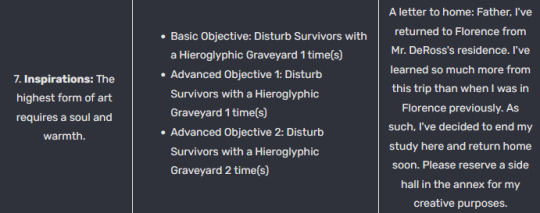
Some time later, we know from Galatea’s 8th deduction that she received “Volume 10 of Ovid's The Metamorphoses”. Based on the stamp with a fern pattern, this means this book came from Baron DeRoss. In Book 10 of Ovid’s The Metamorphoses are a number of stories, including the tale of Orpheus and Eurydice as well as the tale of Pygmalion and the Statue.

In this book, Pygmalion’s story is sung by Orpheus after he loses Eurydice the 2nd time. Pygmalion was a king of Cyprus who swore off women after seeing the vices of some (the Propoitides who had become prostitutes) that lead shameful lives. Instead, he devoted himself to art and sculpted a statue out of ivory of what he felt was the ideal women. He ended up falling in love with his creation (that he’d poured his heart and soul into) due to its beauty. Pygmalion named the statue Galatea and treated it like a real woman. When Aphrodite’s festival day comes, he prayed to her, asking for a wife like his statue, and the goddess brings the statue itself to life, which Pygmalion marries.
This connects very well to Galatea’s accessory Marble Bust, which has the description “It's a shame that it will never be real”.

Pygmalion wanted to create the ideal women after seeing the shameful lives some lived. To Galatea, her current condition is like the shameful women, and like how Pygmalion wanted to create an image of the ideal woman in response, Galatea’s goal is to create a perfect version of herself in response to her diagnosis. We know she works on this upon returning to her parents’ home as Galatea’s deduction 9 is about a “sculpture of a female named ‘Galatea’” that demonstrated Galatea’s “delicate” technique but also displayed the ideal version of herself based on the description of the “elegant curves of the body and tension of life bursting out of it will make it difficult to look away”. Deduction 9 is titled “Effect of Anticipation: You will become the most perfect creation”.

Galatea was finally received admiration and acclaim, as the review sates “the Claude's upcoming star is rising again” but as we heard in Galatea’s 1st letter, she no longer cares about the “praise of fools”, instead describing it as “trivial matters”. All that matters is creating her masterpiece, the image of what Galatea imagines her “perfect self” to look like.
She becomes obsessed with it just like how Pygmalion fell in love with his own creation. Her backstory states her parents noticed she spent more and more time in her work room, to the point she neglected eating and drinking. Her parents became even more concerned when they noticed she “often talked to the statues, as if they were alive”.
This is just like how Pygmalion treated his statue like a real woman before Aphrodite made it real.
This continued until one day, seeing Galatea talking to her statue again, Galatea’s father threw it off the terrace in a fit of range. Unexpectedly for him, Galatea jumps after it “without hesitation”. This connects to Galatea’s deduction 10, which describes the “Broken pieces of plaster scattered all over the floor” of Galatea’s sculpture, the image Galatea created of her “perfect self”.

It is said there were pieces for everything except the head. This could mean Galatea hadn’t finished her creation yet, and still needed to complete the head before her father destroyed the statue.
Galatea as a result of her jumping off the terrace after her creation becomes hemiplegic (paralyzed). This incident also results in Galatea’s parents deciding their daughter was crazy and thus sent her to an asylum, where they used “various inhuman ‘treatment methods’ on Galatea, but her condition did not improve”.
Galatea seems to have eventually ended up at White Sand Street Asylum based on the existence of the headless statue from that trailer appearing in 1 of the cells of White Sand Street Asylum in game.

I think it’s possible Galatea could’ve been at Holloway Sanatorium at least temporarily (then transferred later to White Sand Street Asylum when Galatea’s madness worsened. Or maybe she was here before her trip to the DeRoss manor, as people saw dwarfism as something that also affected a person’s mental abilities, though I prefer the idea that she at least could’ve been at Holloway first then transferred to White Sand later if anything).
We know Galatea was restrained eventually and put in what looks like a cell based on her trailer.

Holloway Sanatorium did have and employ physical restraints, such as straps and jackets, such as to stop patients from injuring themselves or others. Back then, it was more commonly utilized than it is today (not until the 1950s that it was limited to unless a patient was brought in by the police). Seclusion was another form of restraint, with patients confined to ‘strong rooms’ which contained only a bed, chair, and small table. There were four protected or ‘padded’ cells at Holloway, 2 in the male ward and 2 in the female one. In these rooms, the walls were literally padded, and the floor was made from a grey, rubbery, waterproof material. A drain ran around the edge of the room. There would be a mattress on the floor, strong canvas sheets, and a rubber pot was provided for sanitation. The ward doctor had to order a patient to be secluded, which would last from 8am to 8pm, at which point the order had to be renewed.
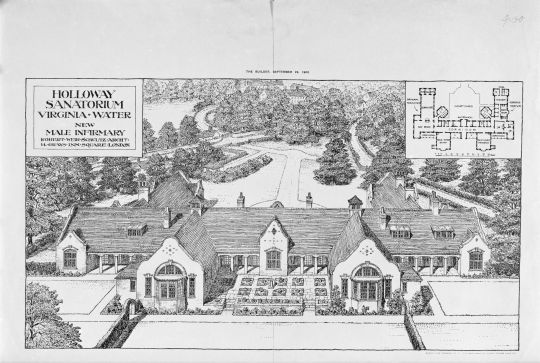

Holloway did also employ treatments that would be considered inhumane today, including hydrotherapy and “continuous baths,” in which the patient would sit for hours in a tub of hot water and have cold water poured over their head. We already mentioned they used physical restraints like straps, jackets, and locked gloves as well as padded rooms. They also did other things including use hypnotic/sedative drugs like chloral and sulfonal, central nervous system depressants like paraldehyde, electrotherapy, force feeding, and more.
So this would still fit the description of where Galatea was sent.
Her backstory states that she refused to communicate with living people and would carve anything she could get her hands on. In her backstory trailer, we see her carving an apple, which matches her Fleeting Beauty accessory. It then says she “always carved out the same face and named it after herself, but due to the limitation of materials, she could only carve out a head before being caught and then treated again”.
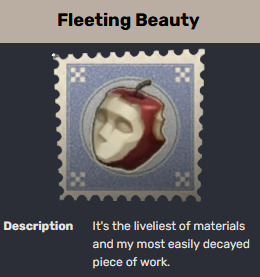
Galatea naming her masterpiece after herself once again connects back to Pygmalion naming his ideal woman Galatea as well as to how this creation is meant to be Galatea’s image of a perfect version of herself.
As we know, Galatea gradually fell into madness, and it was said she was sent to a “remote yard” with a single female nurse taking care of her. This is the same female nurse we see in Galatea’s trailer.
Holloway did at least have a courtyard, and we’ve already discussed the “strong rooms”, which could be described as “remote” and away from the majority of everything else.
When Thomas Holloway was first working to build the sanatorium, he did set out for it not to hold any that were “epileptic, paralysed or dirty” and “no patient was to remain there for more than a year, no hopeless cases were to be admitted, there was to be no readmission” though we know this rule was broken in its early years (Thomas died before the sanatorium was completed), with plenty of examples of patients that stayed more than 1 year, as well as patients that were admitted despite being described as “hopeless cases”, paralyzed, or epileptic. The Sanatorium, despite what it was built for, was primarily concerned about profit (which is why it started doing voluntary admittance to attract customers).
As for the nurse assigned to Galatea, we know Galatea kills her, then placed on her headless body (a “mature woman”) “Galatea's head, which she had sculpted countless times” to complete her “masterpiece”. After that, Galatea disappears, leaving the “blood-soaked hospital room” behind, which the building staff would later find.

We do know Galatea eventually makes her way back to Oletus Manor to attend game 0, the very first game held.
Side not regarding where Galatea was held.
During the Stormy Night Surprise anniversary event, after Succubus is arrested by Sheriff/Officer Jose, Inference goes to her later to ask about Monstrous Bird. He finds her at “an asylum reserved for the wealthy dealing with sensitive familial issues”.
An “asylum” for the “wealthy” fits Holloway Sanatorium (with the “sensitive familial issues” tying to people sent there due to mental issues). And if Succubus was “accustomed to this kind of situation”, that could mean she’s been here before, which could leave an opening for the idea Galatea (looking at the parallels) could’ve been at a mental facility more than just the once (potentially before she was ever paralyzed?).


#idv#identity v#galatea claude#sculptor#idv galatea#identity v galatea#idv sculptor#identity v sculptor#sirenjose analyses and theories
31 notes
·
View notes
Video
youtube
"Total Eclipse of the Heart" is a song recorded by Welsh singer Bonnie Tyler. It was written and produced by Jim Steinman, and released on Tyler's fifth studio album, Faster Than the Speed of Night (1983). It was a #1 hit in her native United Kingdom and In the US the single spent four weeks at the top of the Billboard charts in June 1983.
The music video for the song was directed by Russell Mulcahy and was filmed at the Holloway Sanatorium, a large Victorian Gothic hospital near Virginia Water in Surrey, England.
#Total Eclipse of the Heart#Bonnie Tyler#1983#song#Faster than the Speed of Night#Jim Steinman#Russell Mulcahy#Holloway Sanatorium#single#1980s#music video#Surrey#Virginia Water#80s
39 notes
·
View notes
Photo

Exhibit on Holloway and his Sanatorium yesterday. Proud to have contributed. (at The United Church of Egham) https://www.instagram.com/p/By-bXAFA_Qj/?igshid=l8o69t2t3dqn
1 note
·
View note
Note
Why is the 5th floor called a sanatorium where it looks to be more of a mental asylum since they aren't treating TB patients, but mentally ill patients instead?
That’s a good question, and I don’t know the answer. Perhaps it has something to do with the negative connotations with the word “asylum?”
I did a little research into how the word “sanatorium” was used in the early 20th Century in the UK, and it looks like it’s usually a place for the treatment of tuberculosis (TB), as you mentioned. The entry below on “Sanatorium Treatment in England” is from 1936.

However, I did find a reference to the Holloway Sanatorium, which was built in the late 19th Century for the treatment of mental illness. So, it looks like sanatoriums were usually for the treatment of TB, but the word could also be used as a name for a place for treating people with mental health issues. There are also spelling variations, but those didn’t seem to make a huge difference.
4 notes
·
View notes
Link
Ozzy Osbourne utilizou seu perfil no Instagram nesta tarde de quarta-feira (31) para revelar parte do processo de transformação pelo qual passou para protagonizar o clássico vídeo de “Bark at the Moon”. Em quatro imagens, o cantor mostrou como conseguiu atingir o visual assustador para protagonizar o clipe, que foi parcialmente filmado no Holloway Sanatorium, …
0 notes
Photo

Gabrielle Ray (28 April 1883 - 21 May 1973), English stage actress, dancer and singer, best known for her roles in Edwardian musical comedies. She was considered one of the most beautiful actresses on the London stage and became one of the most photographed women in the world. In the first decade of the 20th century. She died in 1973 at Holloway Sanatorium inEgham, Surrey, England, at the age of 90. #actress #model #gabrielleray
0 notes
Text
♫ Total Eclipse Of The Heart ♫
♫ Total Eclipse Of The Heart ♫
This song from 1983, recorded by Welsh singer Bonnie Tyler, became Tyler’s biggest career hit. The song peaked at No. 1 in the United States, South Africa, Australia, New Zealand, Canada and the United Kingdom. At its peak, it sold 60,000 copies per day, and approximately 6 million copies in total. It was written by Jim Steinman, producer for Meat Loaf (the band, not the food), who said …
“With…
View On WordPress
0 notes
Text
Here’s my report on our visit, in the 2014 Heritage Open Days events, to the Grade 1 listed renovated parts of Holloway Sanatorium, now located inside a gated housing development Virginia Park in Virginia Water.
A extract from the Holloway Sanatorium Wikipedia entry says,
“Thomas Holloway was a Victorian entrepreneur who made a fortune from the sale of his patent medicines, pills and ointments, designed to cure all ills. Where Holloway differed from other ‘quack medicine’ vendors was that he was one of the earliest entrepreneurs to appreciate the value of advertising: he spent huge amounts of money promoting his cures throughout the world and, as a result, reaped huge rewards. Looking for ways in which to spend his fortune, Holloway turned to philanthropy, and became a champion of progressive mental health care.”
Thomas Holloway [1800-1883] married Jane Driver in 1840. They had no children. In newly released book The Holloway Sanatorium by Guy Blythman, he describes Thomas Holloway’s motivation for this building and Royal Holloway College as, ‘Childless, and by 1871 already elderly by standards of the time, he wanted something to be remembered by, though no doubt he was also motivated by genuine altruism.’
While the main building is now converted into luxury apartments, the Entrance Hall, staircase and Recreation Hall of the Holloway Sanatorium have been preserved, and are occasionally open for public view. Here’s my photo montage of them,
Victorian splendour in the Entrance & Recreation Halls at the Holloway Sanatorium Here's my report on our visit, in the 2014 Heritage Open Days events, to the Grade 1 listed renovated parts of
0 notes
Video
vimeo
The Cure - Charlotte Sometimes
One of my favorite songs by The Cure & I really like this music video. I can't view this video on YouTube & other websites since they have it not available for viewing in my country (the States). I was so happy to find it on Vimeo & that I was able to watch it thanks to Nexus for uploading it & not blocking it in my country. : )
The song is based on the 1969 children's novel of the same name by British writer Penelope Farmer. The song was released in 1981 (when I was 1). The music video was filmed at Holloway Sanatorium.
6 notes
·
View notes